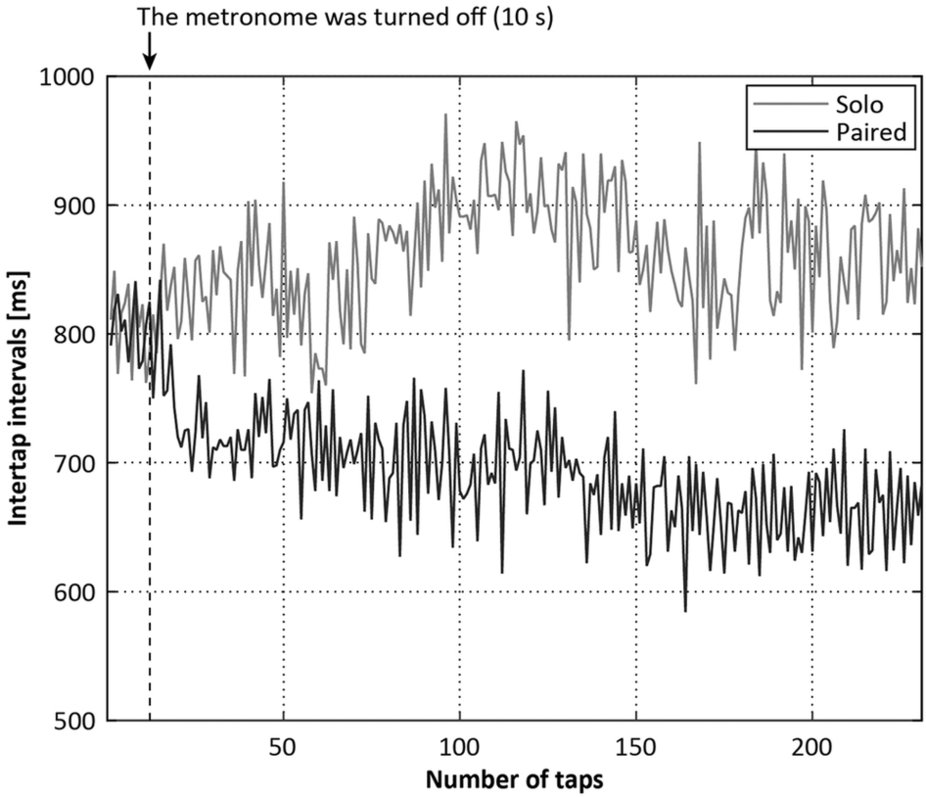外部からのタイミング手がかりがない状態で指タッピングのテンポを保つ課題を2人組で行うと、タイミング調節による同期のために、1人で行う場合よりもテンポが速くなる
Paired Synchronous Rhythmic Finger Tapping without an External Timing Cue Shows Greater Speed Increases Relative to Those for Solo Tapping
2017年3月9日 Scientific Reports 7 : 43987 doi: 10.1038/srep43987

指タップのテンポを一定に保つ「同期—継続(SC)課題」を被験者が1人で行った場合、タップ間隔(ITI)が最初のテンポから逸脱していくことが知られている。2人組や集団では、選択反応課題や、リズミカルな身体の揺れ、コンサートでの拍手などのさまざまな状況において、自分の動作のタイミングを無意識に調節することが明らかになっており、このことから、ITIの変動は2人組という状況にも影響を受ける可能性があると考えられる。今回我々は、被験者が1人もしくは2人組の状況でタッピングのテンポを保つSC課題実験を、3つのテンポ(1分間あたり75、120、200回)について行い、テンポ維持の達成度がテンポの違いによって変わるのか、プレーヤーの数によって変わるのか、それとも両方によるのかを調べた。その結果、2人組でタッピングをした場合に、3つのテンポ全てで、1人の場合に比べてテンポが速くなることが分かった。1人の場合に速くなった被験者について見ると、1人でタッピングした場合のITI逸脱の程度は、2人組でタッピングした場合のものと強く相関していた。回帰分析から、1人の場合に速くなった被験者も遅くなった被験者も、2人組になった場合にはタップのタイミングをパートナーのタイミングに合わせていることが示唆された。これらの結果に対して考えられる説明の1つは、被験者が自身のタップとパートナーのタップのうち速い方に従って、自身の内部計時機構の位相をリセットしているというものである。今回の結果は、2人組という状況によって、ITIを短くしてテンポを速めるようなバイアスがかかる可能性があることを示している。
Masahiro Okano, Masahiro Shinya and Kazutoshi Kudo
Corresponding Authors
In solo synchronization-continuation (SC) tasks, intertap intervals (ITI) are known to drift from the initial tempo. It has been demonstrated that people in paired and group contexts modulate their action timing unconsciously in various situations such as choice reaction tasks, rhythmic body sway, and hand clapping in concerts, which suggests the possibility that ITI drift is also affected by paired context. We conducted solo and paired SC tapping experiments with three tempos (75, 120, and 200 bpm) and examined whether tempo-keeping performance changed according to tempo and/or the number of players. Results indicated that those tapping in the paired conditions were faster, relative to those observed in the solo conditions, for all tempos. For the faster participants, the degree of ITI drift in the solo conditions was strongly correlated with that in the paired conditions. Regression analyses suggested that both faster and slower participants adapted their tap timing to that of their partners. A possible explanation for these results is that the participants reset the phase of their internal clocks according to the faster beat between their own tap and the partners’ tap. Our results indicated that paired context could bias the direction of ITI drift toward decreasing.

